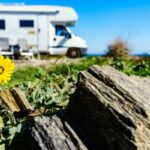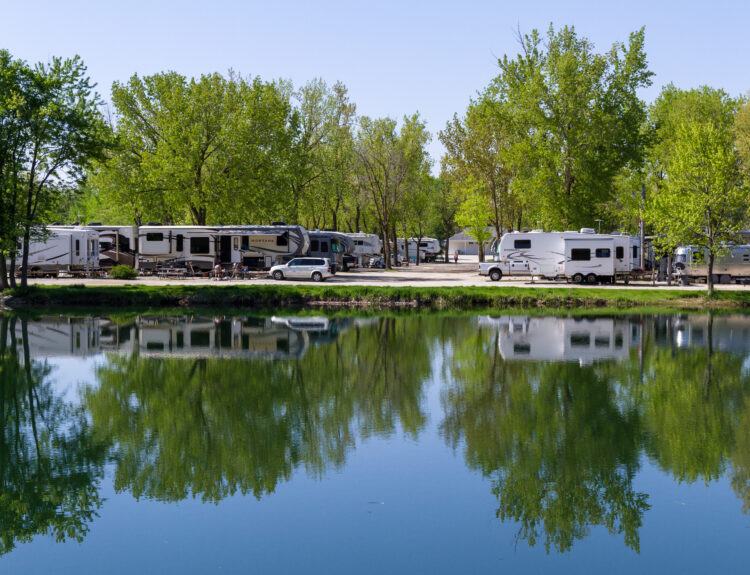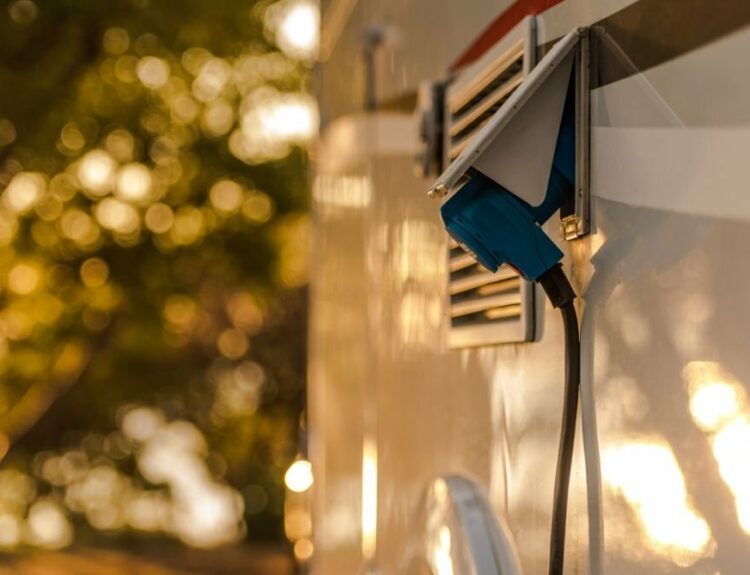Designing a small RV park layout requires a strategic balance between space efficiency, guest comfort, and compliance with U.S. regulations. Whether you’re developing a new park or optimizing an existing one, a well-planned layout enhances operations and creates a welcoming environment for travelers.
In this article, we’ll explore essential design principles, layout configurations, and infrastructure strategies to help small RV park owners maximize space while maintaining functionality.
Key Takeaways
- Small RV park layouts should balance space efficiency with guest comfort and regulatory compliance.
- Pull-through and back-in sites each offer benefits depending on guest preferences and available floor plan.
- Proper infrastructure and floor planning, including road width and drainage, ensures smooth operations.
- Thoughtful placement of amenities and green spaces enhances the guest experience.
- Cost-effective layout optimizations can improve the campsite profitability without requiring major renovations.
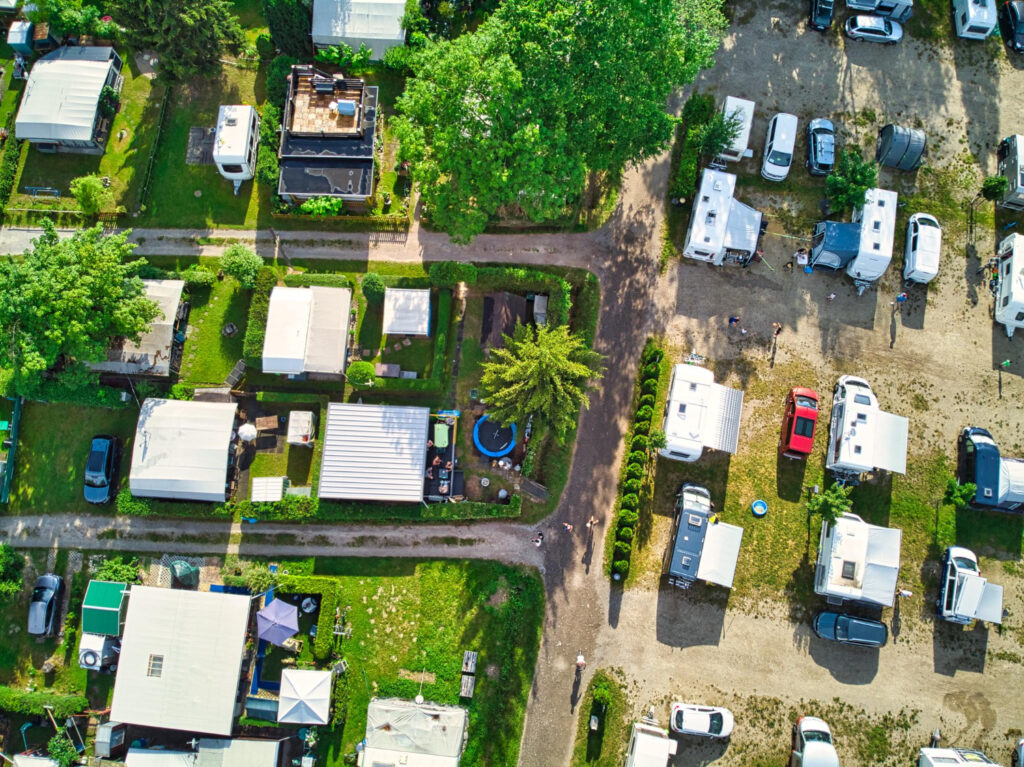
Understanding Small RV Park Layout Essentials
Before diving into specific layout ideas, it’s important to understand the fundamental elements that contribute to a functional and successful RV park. From space requirements to legal compliance, each aspect must be carefully considered, ensuring a smooth experience for both park operators and guests.
Space requirements and site dimensions
A well-planned small RV park layout accommodates different vehicle sizes while ensuring accessibility and ease of maneuvering. Common space requirements include:
- Standard RV site dimensions: at least 20 feet wide by 40 feet long for back-in sites and 12 feet wide by 60 feet long for pull-through sites.
- Lot spacing: A minimum of 10–15 feet between RVs for safety and privacy.
- Driveway clearance: Roads should be at least 12 feet wide for one-way traffic and 20 feet wide for two-way traffic.
Maximizing land use without overcrowding ensures guest comfort while maintaining compliance with local regulations.
U.S. Regulations for Small RV Parks (Zoning, ADA, and Safety)
RV parks in the U.S. must comply with local zoning laws, ADA accessibility standards, and safety regulations. Key requirements include:
- Zoning approvals: Ensure the land is zoned for RV park use and meets setback requirements.
- ADA compliance: at least one ADA-accessible RV site per 25 sites with proper pathways and restrooms.
- Fire safety regulations: designate clear emergency exits and provide fire hydrants or extinguishers at regular intervals.
Utilities and Hookup Considerations (Water, Sewer, Electric, Wi-Fi)
Reliable utility hookups are essential for guest satisfaction. Best practices include:
- Water and sewer: Install full hook-ups (freshwater, sewer, and electrical connections) at each site. Septic tanks should be placed at least 50 feet away from water sources.
- Electric connections: Provide 30-amp and 50-amp options to accommodate different RV needs.
- Wi-Fi access: Position routers and signal boosters strategically to provide strong, park-wide internet coverage.
Proper placement of utility connections prevents overcrowding and enhances the guest experience.
Important Small RV Park Layout Considerations
Every decision in the layout process impacts how smoothly your park operates and how appealing it is to visitors. To create an efficient and guest-friendly design, you’ll need to carefully consider several key factors.
One of the first decisions is site configuration—whether to prioritize pull-through sites for easy access or back-in sites to fit more guests. Road design is equally important, ensuring roads are wide enough for large rigs to maneuver safely while maintaining a logical traffic flow. Spacing between sites also impacts guest experience; too close together, and guests feel cramped, but too far apart, and valuable space is wasted.
Utility placement is another key factor, as water, sewer, and electrical hookups must be positioned efficiently to meet regulations and provide convenience. Common areas and amenities—such as restrooms, laundry, or recreation spaces—should be placed in accessible locations without disrupting quiet areas. Additionally, planning ahead for future expansion can save costs by allowing for seamless growth without major infrastructure overhauls.
Pull-Through vs. Back-In Sites
Both pull-through and back-in sites are essential for creating a well-balanced RV park. Pull-through sites are ideal for overnight guests and large RVs, allowing easy entry and exit without the need to reverse. They provide convenience and reduce congestion but take up more space, limiting the number of sites available.
Back-in sites, on the other hand, are more space-efficient, making it easier to fit more RVs within a small park. They work well for long-term guests who don’t mind maneuvering their vehicles and often offer more privacy.
A good RV park layout includes a mix of both site types to accommodate different guest needs. This balance ensures flexibility for travelers seeking a quick stop as well as those planning an extended stay, ultimately improving the park’s efficiency and appeal.
Angled vs. Perpendicular Parking Layouts
The way RV sites are set up affects how easy it is to park, how people move around, and how well the park works. Angled parking (45–60 degrees) is often the preferred choice for small RV parks because it allows for smoother entry and exit, reducing the need for precise maneuvering. This layout improves traffic flow by naturally guiding vehicles in one direction, minimizing congestion and making it easier for guests to park.
On the other hand, perpendicular parking (90 degrees) maximizes space by fitting more sites into a given area but requires more maneuvering, which can be challenging for larger RVs. While perpendicular layouts may work well in larger parks with ample turning space, angled parking is generally the best option for small RV parks, as it enhances accessibility and ensures a more efficient, stress-free experience for guests.
Maximizing Green Space and Shared Amenities
A well-planned small RV park should balance RV sites with thoughtfully designed communal areas to enhance guest comfort and enjoyment. Incorporating green spaces and picnic areas creates a welcoming atmosphere, giving guests a place to relax outside their RVs.
Walking trails and dog parks add recreational value, catering to both fitness enthusiasts and pet owners. Essential facilities like restrooms, showers, and laundry rooms should be placed in central, easily accessible locations to ensure convenience without disrupting the privacy of campsites.
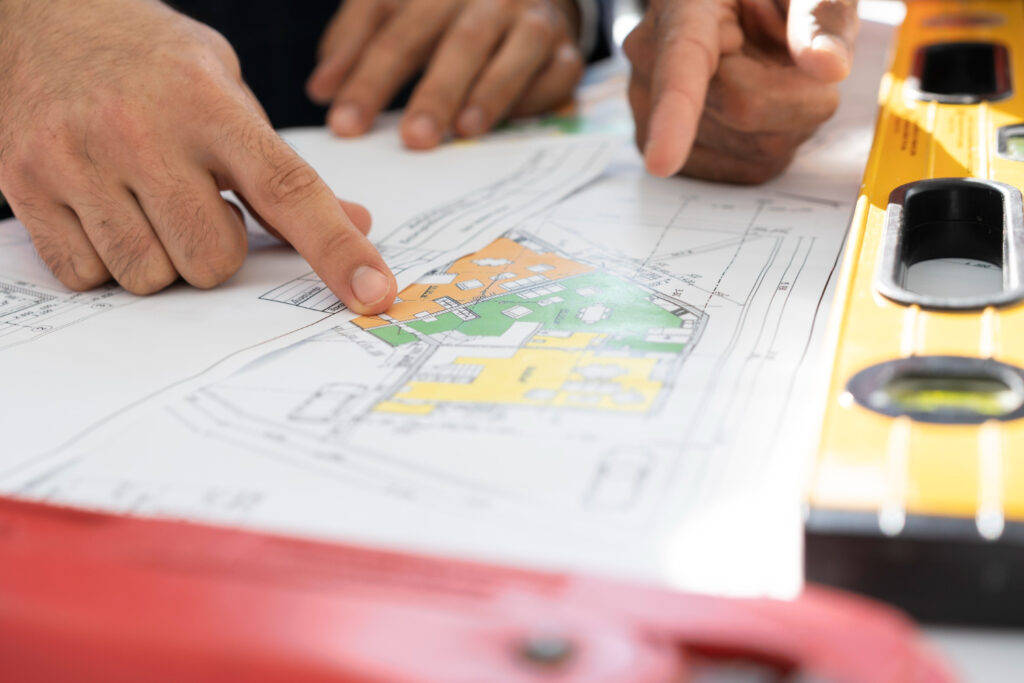
Infrastructure Planning for Efficiency
Beyond site placement, a well-thought-out infrastructure plan is necessary for smooth park operations. Road design, drainage systems, and waste management all play a role in keeping the park functional and safe.
Road Width and Traffic Flow for Easy Maneuvering
Since RVs vary in size, roads must be wide enough to accommodate everything from small camper vans to big motorhomes with tow vehicles. To ensure easy navigation, industry recommendations suggest 12-foot-wide one-way roads and 20-foot-wide two-way roads, providing enough clearance for safe passing and turning.
Intersections should be designed with large turning radii to allow longer RVs to maneuver without difficulty. Using gentle curves and well-spaced intersections helps prevent backups and improve the guest experience. Additionally, clear directional signage should be placed strategically throughout the park, guiding guests to their sites, amenities, and exits with minimal confusion.
The entrance design is another critical aspect of traffic flow. A well-planned entrance and exit system makes it easier to arrive and leave, which reduces wait times and prevents congestion at peak check-in hours. Ideally, the entrance should be wide enough to accommodate simultaneous incoming and outgoing traffic while being positioned in a way that maximizes space utilization.
Best Practices for Drainage and Flood Prevention
Poor drainage can lead to major issues like flooding and site erosion. Strategies include:
- Grading the land to direct water away from RV sites.
- Installing gravel or permeable pavers for improved drainage.
- Using retention ponds or drainage ditches to manage excess water.
These measures help prevent long-term water damage and ensure year-round usability.
Waste Disposal and Septic System Placement
Proper waste management is essential for maintaining hygiene and environmental sustainability:
- Septic tanks should be placed away from high-traffic areas and water sources.
- Dump stations should be easily accessible but not near guest recreation areas.
- Trash collection points should be well distributed and emptied regularly.
Strategic placement of waste management facilities keeps the park clean and compliant with health regulations.

Enhancing Guest Experience in a Small RV Park
A successful campground goes beyond functionality—it should also provide an enjoyable experience for guests. Thoughtful design choices can make a small RV park feel welcoming and convenient, ensuring repeat visits and positive reviews.
Designing common areas and recreational areas
Guests appreciate designated spaces for relaxation and socialization. Consider incorporating:
- Fire pit, picnic table, or a BBQ area for group gatherings.
- Clubhouses or game rooms for indoor activities.
- Playgrounds or pet-friendly zones to cater to families and pet owners.
- Well-Planned Hiking Trails: Incorporate scenic, easy-to-navigate trails that loop around the park, connecting key areas like campsites, common spaces, and natural landmarks for outdoor enthusiasts.
These amenities enhance the overall guest experience and increase return visits.
Effective Signage and Lighting for Safety
Clear signage and well-placed lighting are essential for both navigation and security in an RV park. Well-designed directional signs help guests find their way easily, reducing confusion and traffic congestion, especially in parks with multiple loops or amenities. Signs should be large, easy to read, and strategically placed at entrances, intersections, and near key facilities like restrooms, laundry areas, and exits.
Equally important is proper lighting, which enhances safety and improves the overall guest experience. Well-lit pathways, parking areas, and communal spaces prevent accidents, deter potential security risks, and make nighttime navigation easier. Using solar-powered lighting can be a cost-effective and environmentally friendly option, providing reliable illumination without increasing energy costs. Motion-sensor lights in low-traffic areas can also improve security while reducing unnecessary energy use.
By prioritizing clear signage and effective lighting, RV park owners create a safer, more welcoming environment for guests..
Sustainable and Eco-Friendly Park Features
Incorporating sustainable and eco-friendly features in an RV park reduces environmental impact and saves money in the long run.
One of the most effective upgrades is solar energy, which can power common areas, lighting, and even individual RV hookups, significantly reducing electricity costs. Moreover, rainwater collection systems can also be used to water plants, wash cars, or provide non-potable water to facilities, conserving the area’s water resources.
Another key feature is native landscaping, which replaces traditional grass and high-maintenance plants with drought-resistant species that require less water and upkeep. This saves water and creates a natural look that matches the surroundings.
By integrating these eco-friendly elements, RV parks owners can reduce operational expenses, comply with sustainability regulations, and attract travelers who prioritize green living.

Cost-effective Ways to Optimize a Small RV Park Layout
Improving an RV park layout doesn’t always require expensive renovations. Smart, cost-effective upgrades can enhance space efficiency and guest comfort without breaking the bank.
Budget-Friendly Upgrades for Existing Parks
Improving an existing RV park doesn’t have to mean expensive renovations—small, strategic upgrades can significantly improve the guest experience and park efficiency without breaking the bank. One of the most impactful yet cost-effective improvements is resurfacing roads and driveways. Roads that are smooth and well-kept make it easier for visitors to go through, save money on vehicles, and look professional.
Upgrading utilities is another smart move, such as upgrading electrical connections or upgrading water and drainage systems. These changes make guests’ experiences better, save money on maintenance, and prevent expensive repairs.
Guest comfort is another key consideration, and simple additions can make a big difference. Installing shade structures, picnic tables, or outdoor seating areas provides much-needed relief in hot weather and encourages guests to enjoy communal spaces.
Modular and Expandable Layout Designs
Planning for future growth is important for the long-term success of a small RV park. A modular layout allows for a phased expansion approach, meaning that you can start with a smaller number of sites and gradually add more as demand increases. This strategy helps manage initial costs while ensuring the park remains adaptable to future needs.
Also, designing flexible-use spaces, such as open areas that can later be turned into RV sites, storage, or amenities, allows your park to evolve without having to make major changes. The guest experience remains smooth even during expansion because modular planning minimizes disruptions when adding new features like restrooms, laundry facilities, or recreational areas.
Essential Tools for a Small RV Park
Running a small RV park efficiently requires the right tools and software to streamline operations, manage reservations, and enhance guest experiences. From booking management systems to utility tracking tools, investing in the right technology can help small park owners save time and increase revenue.
RoverPass: The Best Software for Small and Medium RV Parks
For small and medium-sized RV parks, RoverPass is an ideal reservation and management software designed to simplify park operations. With features tailored for smaller parks, RoverPass helps owners:
- Manage bookings effortlessly with an easy-to-use reservation system.
- Accept online reservations and payments to reduce administrative workload.
- Handle guest check-ins and cancellations with a seamless system.
- Offer dynamic pricing and availability tracking to maximize revenue.
Additional Tools to Enhance Small RV Park Operations
Beyond reservation software, other tools can help streamline operations and improve efficiency:
- Accounting Software – QuickBooks or Xero for tracking finances and expenses.
- Utility Monitoring Systems – Smart meters for tracking electricity and water usage.
- Wi-Fi Management Tools – Cloud-based networking solutions to ensure reliable guest internet.
- Security and Access Control – Keypad or RFID-based gate access for improved security.
Investing in the right tools allows small RV park owners to save time, reduce operational costs, and focus on delivering a great guest experience. Whether you’re starting a new park or optimizing an existing one, choosing the right technology—like RoverPass—can make all the difference in running a successful and profitable small RV park.
Frequently Asked Questions
1. What is the ideal lot size for a small RV park?
A 5- to 10-acre property can typically fit 20 to 50 RV sites, depending on spacing, roads, and amenities. Each site should be 1,200 to 2,000 square feet to allow for RVs, slide-outs, and outdoor space.
2. What are the minimum spacing requirements between RV sites?
Most parks should have at least 10 to 15 feet between RVs for privacy and fire safety. Some areas require 20 feet or more. Always check local zoning laws and NFPA 1194 standards for compliance.
3. Should I use pull-through or back-in RV sites for a small park?
Pull-through sites are ideal for overnight guests and larger RVs since they make parking and exiting easier without requiring backing up. Back-in sites, on the other hand, are more space-efficient and better suited for long-term guests who don’t need to move frequently.
4. What utilities should be included in a small RV park layout?
A well-equipped small RV park should provide electric hookups with both 30-amp and 50-amp options, water connections with freeze-proof spigots, and sewer or dump stations for waste disposal. Reliable Wi-Fi access also enhances guest satisfaction, as rv travelers rely on connectivity for work, entertainment, and trip planning.
5. How can I make my small RV park more profitable?
Maximizing rv space efficiency, offering premium cabins with full hookups, and providing additional services like laundry, propane refills, and equipment rentals can boost profitability for campground owners.



